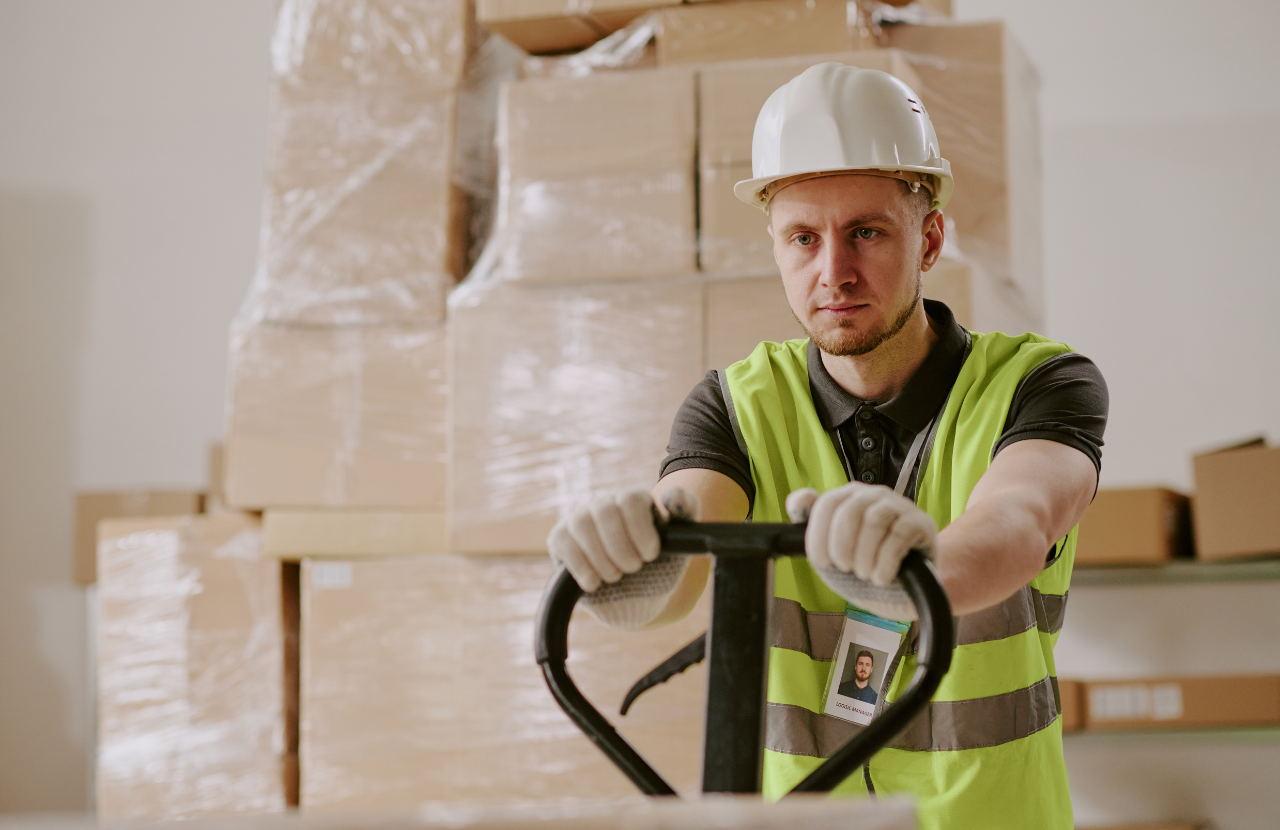
Effective manual handling lifting techniques help prevent musculoskeletal injuries and support safer working practices.
According to the HSE, handling, lifting or carrying accounted for 17% of all non-fatal injuries reported under RIDDOR in 2023/24. Simple improvements in planning, preparation and lifting technique can make a significant difference to comfort and safety.
In this guide we share the principles that underpin safer manual handling. We discuss how to approach a handling task, how to set up the lift, what movements support control, and which actions are best avoided.
What are the four principles of manual handling?
Manual handling lifting techniques should always be grounded in four core principles that reflect the Manual Handling Operations Regulations (MHOR) hierarchy of control and Health and Safety Executive (HSE) guidance.
1. Avoid hazardous manual handling where reasonably practicable
Before considering technique or training, determine whether the handling activity needs to be carried out manually at all.
- Can the task be reorganised?
- Can materials be delivered closer to the point of use?
- Can the load be broken down into smaller units or packaged differently?
Eliminating the requirement for manual lifting removes the risk at source.
2. Assess the risk where manual handling cannot be avoided
Where the manual handling task must still take place, the risk must be assessed first. Tools such as TILE / TILEO (Task, Individual, Load, Environment, Other factors) provide a structured method for this assessment:
Task
Look at what is involved in the activity.
For example:
- What route will the load take and is that route suitable?
- How far does the load need to be carried?
- Does the task involve twisting or reaching?
- Is the task repetitive?
Individual
Consider the person who will be lifting.
For example:
- Are they physically capable and trained to do the task?
- Are there any health concerns (for example, back injury, pregnancy)?
Load
Assess the characteristics of the object being moved.
For example:
- Is it heavy, large or awkward to grip?
- Is the centre of gravity uneven or unstable?
Environment
Look at the conditions the lift will take place in.
For example:
- Is the floor slippery or uneven?
- Is lighting adequate?
- Are there temperature extremes or weather issues?
- Are there obstructions in the route that could be removed or repositioned before the lift?
Other factors
Identify any additional influences that could increase risk.
For example:
- Time pressure or rushing
- PPE or clothing that restricts movement
- Whether assistance from another person or a suitable handling aid is required
3. Reduce the risk as far as is reasonably practicable
Once the risks have been identified, apply suitable controls. This may include:
- Using mechanical aids such as pallet trucks, trolleys, sack trucks, dollies, conveyor systems, powered lifting platforms or scissor lifts. These devices significantly reduce the manual force required and should be used wherever they are available and suitable. Mechanical aids should be selected based on load type, travel distance, surface conditions and the space available.
- Modifying the task to make the lift lower risk. For example, splitting heavier deliveries into smaller loads, adjusting storage arrangements so that heavy items are stored at waist height rather than floor or shoulder height, or delivering materials closer to the point of use to reduce unnecessary handling.
- Assigning a team lift where the load cannot be handled safely by one person alone. Team lifting requires coordination, clear communication and agreement on who will lead the movement to ensure the lift remains controlled and balanced throughout.
- Planning the route in advance to avoid hazards during movement. This might involve identifying and removing obstructions, selecting a route without tight corners or steep gradients, ensuring the floor surface is suitable, and confirming that doorways, access spaces or lift areas are wide enough to allow safe manoeuvring.
Administrative controls may also be used in combination with equipment and task modification. These may include:
- Supervision to enforce safe systems of work
- Signage to guide correct lifting behaviour
- Limiting the frequency or duration of manual handling activities
- Rotating tasks so that the same individuals are not exposed to repetitive or prolonged lifting throughout the day.
4. Follow safer manual handling steps and communicate effectively
Only after the above controls are in place should lifting techniques be applied (see below).
Clear communication is critical, particularly in team lifts. For more information about this, please read our guide, Manual handling safety: 10 team lifting tips.
Where should you hold and carry your load?
Before lifting, decide how you will hold the item and bring it as close to your body as is reasonably practicable. Keeping the load close to your centre of gravity (around waist height) helps reduce stress on the spine and maintains control.
Practical ways to achieve this include:
- Sliding the load towards you before lifting rather than reaching out
- Using available handholds or grip points
- Adjusting the work height if possible (for example, placing the load on a pallet or bench before lifting).
Your stance should enable you to balance and move steadily. Avoid having your feet too close together, as this reduces stability. A stable stance (see below) supports smoother, more controlled movement and lowers the risk of unplanned shifts or loss of balance.
What is the correct technique for lifting an inanimate load?
There is no single universal correct way to lift because every handling task depends on different factors (such as the size and shape of the load, the height it starts from, the height it is going to, and the space available).
However, the aim should always be to begin the lift in a stable position and then use movement patterns that maintain control and reduce strain as the lift progresses.
A stable, controlled lift involves:
- Positioning your feet to provide balance and stability before the lift begins
- Keeping the load close to the body throughout the movement
- Engaging the hips and legs to take most of the effort rather than relying on the back
- Maintaining a neutral spine rather than bending or twisting under load
- Moving smoothly, avoiding sudden or jerking motions that can cause loss of control
- Planning how you will change direction before starting the lift so the route is deliberate and controlled.
These represent proper lifting techniques in practice. Effective manual handling techniques are about thinking ahead, planning the movement and adapting to the specific task, load and environment – not attempting to apply a single “ideal” lift to every situation.
What should you not do when lifting a load?
There are several actions that significantly increase the risk of injury and should be avoided during manual handling.
Do not:
- Twist the spine while lifting or lowering. If you need to turn, move your feet and whole body together rather than rotating at the waist.
- Lift while reaching or stretching. Bringing the load closer before lifting reduces leverage forces and protects the lower back.
- Lift with arms fully extended. Holding the load away from the body loses control and places excessive strain on the shoulders and spine.
- Bend from the waist to begin the lift. Starting a lift this way concentrates force on the lumbar region and increases the risk of sudden strain.
If a lift begins to feel forced, unstable or difficult to control, the activity should be stopped and reassessed rather than continued.
Learn safer manual handling lifting techniques and processes
Our Manual Handling Course helps employees handle loads safely and supports compliance with the Manual Handling Operations Regulations 1992 (MHOR).
Learners are guided through how to assess tasks before lifting, how to apply manual handling lifting techniques that reduce strain, and how to recognise when handling aids, assistance or task modification are needed.
The Manual Handling Course can be tailored to your organisation, and it is available as eLearning, face-to-face at a venue of your choice, or via a virtual classroom. Find out more on our website, or contact our friendly team on 0203 011 4242 / info@praxis452.com

Adam Clarke
Managing Director (Consulting)
